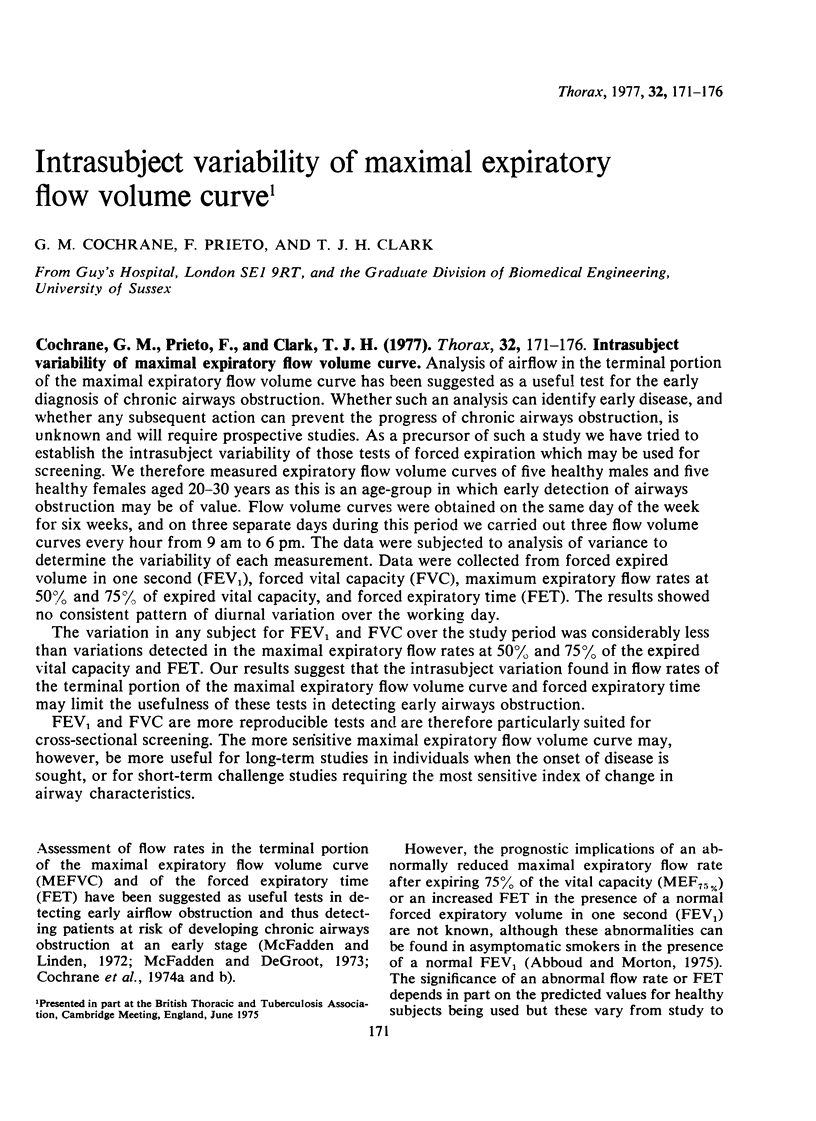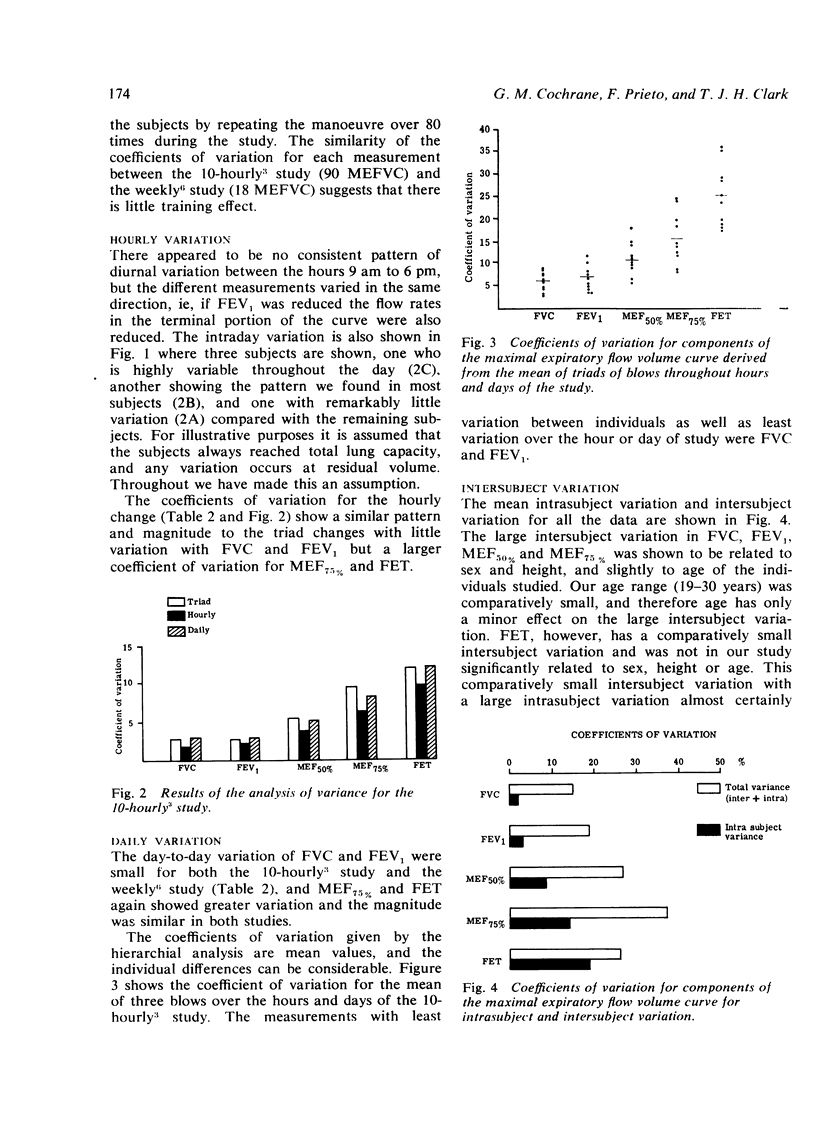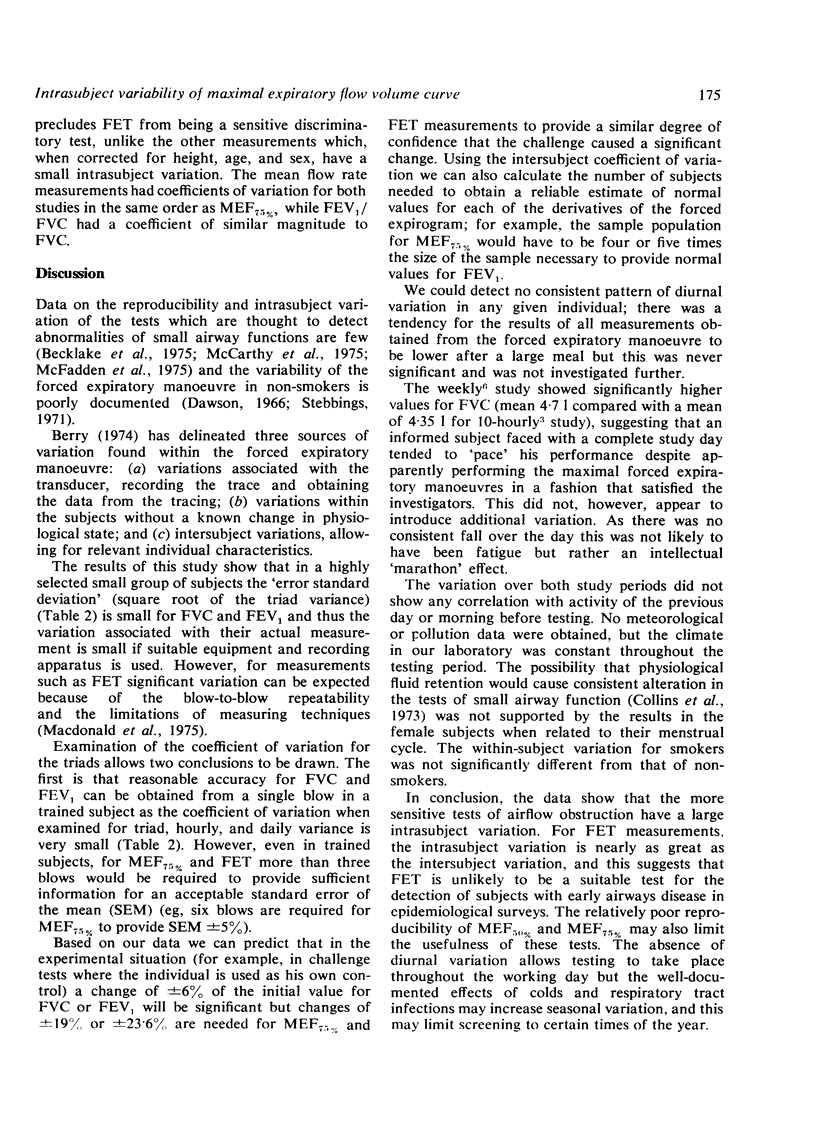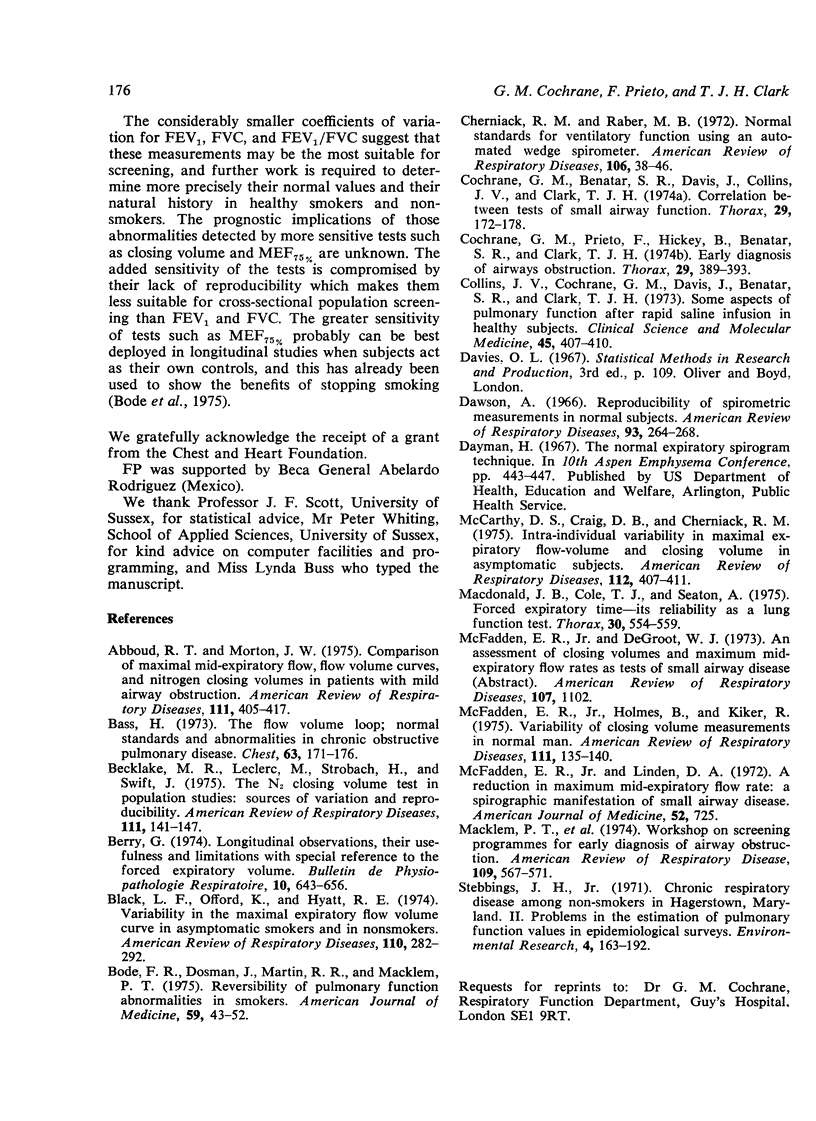Abstract
Analysis of airflow in the terminal portion of the maximal expiratory flow volume curve has been suggested as a useful test for the early diagnosis of chronic airways obstruction. Whether such an analysis can identify early disease, and whether any subsequent action can prevent the progress of chronic airways obstruction, is unknown and will require prospective studies. As a precursor of such a study we have tried to establish the intrasubject variability of those tests of forced expiration which may be used for screening. We therefore measured expiratory flow volume curves of five healthy males and five healthy females aged 20-30 years as this is an age-group in which early detection of airways obstruction may be of value. Flow volume curves were obtained on the same day of the week for six weeks, and on three separate days during this period we carried out three flow volume curves every hour from 9 am to 6 pm. The data were subjected to analysis of variance to determine the variability of each measurement. Data were collected from forced expired volume in one second (FEV1) forced vital capacity (FVC), maximum expiratory flow rates at 50% and 75% of expired vital capacity, and forced expiratory time (FET). The results showed no consistent pattern of diurnal variation over the working day. The variation in any subject for FEV1 and FVC over the study period was considerably less than variations detected in the maximal expiratory flow rates at 50% and 75% of the expired vital capacity and FET. Our results suggest that the intrasubject variation found in flow rates of the terminal portion of the maximal expiratory flow volume curve and forced expiratory time may limit the usefulness of these tests in detecting early airways obstruction. FEV1 and FVC are more reproducible tests and are therefore particularly suited for cross-sectional screening. The more sensitive maximal expiratory flow volume curve may, however, be more useful for long-term studies in individuals when the onset of disease is sought, or for short-term challenge studies requiring the most sensitive index of change in airway characteristics.
Full text
PDF





Selected References
These references are in PubMed. This may not be the complete list of references from this article.
- Abboud R. T., Morton J. W. Comparison of maximal mid-expiratory flow, flow volume curves, and nitrogen closing volumes in patients with mild airway obstruction. Am Rev Respir Dis. 1975 Apr;111(4):405–417. doi: 10.1164/arrd.1975.111.4.405. [DOI] [PubMed] [Google Scholar]
- Bass H. The flow volume loop: normal standards and abnormalities in chronic obstructive pulmonary disease. Chest. 1973 Feb;63(2):171–176. doi: 10.1378/chest.63.2.171. [DOI] [PubMed] [Google Scholar]
- Becklake M. R., Leclerc M., Strobach H., Swift J. The N2 closing volume test in population studies: sources of variation and reproducibility. Am Rev Respir Dis. 1975 Feb;111(2):141–147. doi: 10.1164/arrd.1975.111.2.141. [DOI] [PubMed] [Google Scholar]
- Berry G. Longitudinal observations. Their usefulness and limitations with special reference to the forced expiratory volume. Bull Physiopathol Respir (Nancy) 1974 Sep-Oct;10(5):643–656. [PubMed] [Google Scholar]
- Black L. F., Offord K., Hyatt R. E. Variability in the maximal expiratory flow volume curve in asymptomatic smokers and in nonsmokers. Am Rev Respir Dis. 1974 Sep;110(3):282–292. doi: 10.1164/arrd.1974.110.3.282. [DOI] [PubMed] [Google Scholar]
- Bode F. R., Dosman J., Martin R. R., Macklem P. T. Reversibility of pulmonary function abnormalities in smokers. A prospective study of early diagnostic tests of small airways disease. Am J Med. 1975 Jul;59(1):43–52. doi: 10.1016/0002-9343(75)90320-4. [DOI] [PubMed] [Google Scholar]
- Cherniack R. M., Raber M. B. Normal standards for ventilatory function using an automated wedge spirometer. Am Rev Respir Dis. 1972 Jul;106(1):38–46. doi: 10.1164/arrd.1972.106.1.38. [DOI] [PubMed] [Google Scholar]
- Cochrane G. M., Benatar S. R., Davis J., Collins J. V., Clark T. J. Correlation between tests of small airway function. Thorax. 1974 Mar;29(2):172–178. doi: 10.1136/thx.29.2.172. [DOI] [PMC free article] [PubMed] [Google Scholar]
- Cochrane G. M., Prieto F., Hickey B., Benatar S. R., Clark T. J. Early diagnosis of airways obstruction. Thorax. 1974 Jul;29(4):389–393. doi: 10.1136/thx.29.4.389. [DOI] [PMC free article] [PubMed] [Google Scholar]
- Collins J. V., Cochrane G. M., Davis J., Benatar S. R., Clark T. J. Some aspects of pulmonary function after rapid saline infusion in healthy subjects. Clin Sci Mol Med. 1973 Sep;45(3):407–410. doi: 10.1042/cs0450407. [DOI] [PubMed] [Google Scholar]
- Dawson A. Reproducibility of spirometric measurements in normal subjects. Am Rev Respir Dis. 1966 Feb;93(2):264–268. doi: 10.1164/arrd.1966.93.2.264. [DOI] [PubMed] [Google Scholar]
- Dayman H. The normal expiratory spirogram--technique. Aspen Emphysema Conf. 1967;10:443–447. [PubMed] [Google Scholar]
- Macdonald J. B., Cole T. J., Seaton A. Forced expiratory time--its reliability as a lung function test. Thorax. 1975 Oct;30(5):554–559. doi: 10.1136/thx.30.5.554. [DOI] [PMC free article] [PubMed] [Google Scholar]
- Macklem P. T. Workshop on screening programs for early diagnosis of airway obstruction. Am Rev Respir Dis. 1974 May;109(5):567–571. doi: 10.1164/arrd.1974.109.5.567. [DOI] [PubMed] [Google Scholar]
- McCarthy D. S., Craig D. B., Cherniack R. M. Intraindividual variability in maximal expiratory flow-volume and closing volume in asymptomatic subjects. Am Rev Respir Dis. 1975 Sep;112(3):407–411. doi: 10.1164/arrd.1975.112.3.407. [DOI] [PubMed] [Google Scholar]
- McFadden E. R., Jr, Linden D. A. A reduction in maximum mid-expiratory flow rate. A spirographic manifestation of small airway disease. Am J Med. 1972 Jun;52(6):725–737. doi: 10.1016/0002-9343(72)90078-2. [DOI] [PubMed] [Google Scholar]
- McFadden E. R., Jr, holmes B., Kiker R. Variability of closing volume measurements in normal man. Am Rev Respir Dis. 1975 Feb;111(2):135–140. doi: 10.1164/arrd.1975.111.2.135. [DOI] [PubMed] [Google Scholar]
- Stebbings J. H., Jr Chronic respiratory disease among nonsmokers in Hagerstown, Maryland. II. Problems in the estimation of pulmonary function values in epidemiological surveys. Environ Res. 1971 Apr;4(2):163–192. doi: 10.1016/0013-9351(71)90044-2. [DOI] [PubMed] [Google Scholar]


